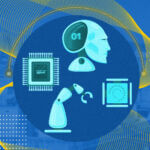
IoT Without Big Data is Nothing
Imagine Industrial IoT as the nervous system of a company: it is a network of sensors that collects valuable information from all corners of a production plant and stores it in a repository for data analysis and exploitation. This network is necessary to measure and obtain data in order to make informed decisions. But what happens next? what should we do with all that data? We always talk about making good decisions based on reliable information, but although it may sound obvious, it is not always that easy to achieve that goal. In this article, we will go a bit beyond IoT and will focus on the data and how to leverage it with AIoT and data analytics.
We’ll be discussing specifically the analysis phase, the process that turns data first into information and then into knowledge (sometimes also referred to as business logic). In the end, however, we won’t stray far from the core subject of IoT, because for us IoT without Big Data is meaningless.
Big Data and Data Analytics
In recent decades, especially in the ’10’s, we have witnessed an incredible flood of data (both structured and unstructured), mass-produced by the ubiquity of digital technologies. In the particular case of the industrial world, taking advantage of and fully utilizing this huge amount of information is paramount to success.
This need to process business data has given rise to the largely interchangeable terms “Big Data,” “Data Science,” and “Data Analytics,” which we could collectively define as the processes we follow to examine the data captured by our network of devices, with the goal of revealing obfuscated trends, patterns or correlations. This is done with the underlying goal of improving the business with new types of knowledge.
Because it is a recently created term, there are different definitions for Big Data. One of them provided by Gartner outlines 3 key aspects: the volume of data, its variety, and the velocity with which it is captured. These are commonly referred to as the 3 V’s, although other definitions expand on this to include 5 V’s, adding the veracity of the data and the value they bring to the business.
We believe, though, that it does not make much sense to go into theoretical disquisitions on what does and does not qualify as Big Data, because thanks to the ubiquity of data collection devices, Big Data analysis and processing is already applicable to large swaths of the industrial world.
IoT and Big Data
How do IoT and Big Data relate to each other? The main point of connection is usually a database. In general terms, we could say that the work of IoT ends at that database; put another way, the goal of IoT is to dump all the data acquired in a more or less orderly manner in a common repository. The domain of Big Data starts by accessing that repository to manipulate the acquired data and get the information needed.
In any case, it is useful to visualize IoT Big Data Analytics as a toolbox. Depending on the type of information and knowledge we want to acquire from the data, we will draw one tool or another from it. Many of these tools come in the form of traditional algorithms, as well as improvements to or adaptations of those algorithms, with very similar statistical and algebraic principles. These algorithms were not invented in this century, to the surprise of many who wonder why they are now more relevant than before.
The quick answer is that the volume of data available is now much greater than when said algorithms were first conceived, but more importantly, the computing power of today’s machines allows the use of these techniques on a larger scale, giving new uses to old methodologies.
But we don’t want to give the impression that everything has already been invented and that the current trend in data analysis has brought nothing new to the table; quite the opposite in fact. The data ecosystem is very broad and has witnessed significant innovation in recent years.
One of those fastest-growing areas is Artificial Intelligence. It could be argued that this does not count as a recent invention, since this phenomenon was discussed as early as 1956. However, Artificial Intelligence is so broad a concept and its impact so widespread that it is often considered a self-contained discipline. The reality however is that, in some ways, it plays an integral part in Big Data and Data Analytics. It is another of the tools that are already contained in our metaphorical toolbox but found a natural evolution with AIoT.
AIoT: the Artificial Intelligence of Things
The exponential growth in the volume of data requires novel ways of analyzing it. In this context, Artificial Intelligence becomes particularly relevant. According to Forbes, the two main trends that are dominating the technology industry are the Internet of Things (IoT) and Artificial Intelligence.
IoT and AI are two independent technologies that have a significant impact on each other. While IoT can be thought of as the digital nervous system, AI would likewise be an advanced brain that makes the decisions that control the overall system. According to IBM, the true potential of IoT will only be achieved through the introduction of AIoT.
But what is Artificial Intelligence, and how is it different from conventional algorithms?
We usually speak of Artificial Intelligence when a machine mimics the cognitive functions of humans. That is, it solves problems in the same way as a human would, or hypothetically if a machine were able to find new ways of understanding data. AI’s strength is its ability to generate new algorithms to solve complex problems -and this is the key- independently of a programmer’s input. Thus we could think of Artificial Intelligence in general and Machine Learning in particular (which is the segment within AI with the greatest projected potential for growth) as algorithms that invent algorithms.
Edge AI and Cloud AI
The combination of IoT and AI brings us the concept of AIoT (Artificial Intelligence of Things), intelligent and connected systems that are able to make decisions on their own, evaluate the results of these decisions, and improve over time.
This combination can be done in several ways, of which we would like to highlight two:
- On the one hand we could continue to conceptualize AI as a centralized system that processes all impulses and makes decisions. In this case we would be referring to a system in the cloud that centrally receives all telemetry and acts accordingly. This would be referred to as Cloud AI (Artificial Intelligence in the Cloud).
- On the other hand, we must also talk about a very important part of our metaphorical nervous system: reflexes. Reflexes are autonomous decisions that the nervous system makes without the need to send all the information to the central processor (the brain). These decisions are made in the periphery, close to the source where data was originated. This is called Edge AI (Artificial Intelligence at the Edge).
Use Cases for Edge AI and Cloud AI
Cloud AI provides a thorough analysis process that takes into account the entire system, whereas Edge AI gives us rapidity of response and autonomy. But as with the human body, these two ways of reacting are not mutually exclusive, and can in fact be complementary.
As an example, a water control system can block a valve in the field the moment it detects a leak to prevent major water losses and, in parallel, send a notification to the central system where higher-level decisions can be made, such as opening alternative valves to channel water through another circuit.
The possibilities are endless and can go beyond this simplified example of reactive maintenance, with a sophisticated system able to predict possible events and thus, enabling the possibility of predictive maintenance.
Another example of AIoT data analytics can be found in Smart Grids, where we have smart devices at the edge analyzing the electricity flows at each node and making load balancing decisions locally, while in parallel it sends all this data to the cloud for analysis to generate a more comprehensive, nationwide energy strategy. Macroscopic level analysis would allow load balancing decisions to be made at a regional level, or even decreasing or increasing electricity production by shutting down hydroelectric plants or launching a power purchase process from a neighbouring country.





 New Episode
New Episode





 Latest IoT News
Latest IoT News









